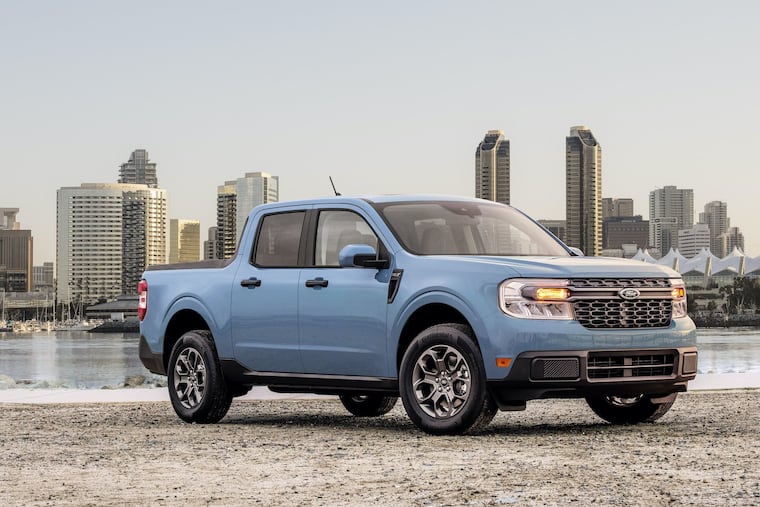2022 Ford Maverick: You can almost have it all
Ford’s new small pickup truck offers a hybrid engine and all-wheel drive, but you can’t get them in the same truck. But the hybrid does a lot of things well.

2022 Ford Maverick FWD Hybrid Lariat: Super economical useful all-wheel-drive truck?
Price: $32,990 as tested. $3,340 for Lariat Luxury Package, $1,495 for First Edition Package, $540 for Ford Copilot 360, $495 for red paint.
Conventional wisdom: Motor Trend headlines a review of a comparable model with “thrifty, awesome fun.”
Marketer’s pitch: “Make it with Maverick.”
Reality: You can have economical or all-wheel drive; pick one. And “useful” is in the bed of the beholder.
What’s new: The whole Maverick. Readers of a certain age will recall the round-bodied Ford from the ‘70s that was replaced by the squared-off Fairmont for the 1978 model year. Neither was a remarkable car, although some early Maverick editions did have something akin to horsepower.
The new Maverick is much more remarkable, putting a hybrid engine into a small pickup, but only if you opt for front-wheel drive. If you want to tow more or enjoy all-wheel drive, you’ll have to un-hybrid the Maverick: a 2.0-liter EcoBoost engine is available.
Ford touts it started “under $19,995,” but that would be a very sad truck, indeed, and nothing like what we have here.
Up to speed: The 2.5-liter four is mated to a 94-kw electric motor that produces a total of 191 horsepower. The front-wheel-drive version tested gets to 60 mph in 7.6 seconds, according to Motor Trend.
An optional 2.0-liter EcoBoost four creates 250 horsepower without hybridization and is the only engine available for the all-wheel-drive version. It takes a quick 5.9 seconds to 60 mph, says Car and Driver.
The Maverick handles highways admirably, though. We visited the Antique Automobile Club of America’s Hershey museum and for the return trip followed the turnpike back to Sturgis Kid 1.0′s home in Montgomery County. The right lane remains an up-and-down ride, so many drivers stay in the left lane to avoid bumps.
This means some high-speed right-lane passing while trying to safely squeeze between cars. The Maverick sped forth without hesitation.
Shiftless: The CVT is operated through the Ford dial, which features a twist knob to get from Park to Reverse or Drive. A Low button sits in the center. No shiftability is available with the hybrid.
On the road: Contrary to C&D’s report, the Maverick suspension stood up to the bump-laden turnpike just fine.
Sport mode provided tight steering and some decent cornering fun, but it’s no Ranger SXT.
One note: The mode button was completely lost to me until I spent a morning actively deciphering the three console buttons, where I saw the leaf and racing flag icons. But the Maverick did well in Eco and Normal modes, as well.
Driver’s Seat: The Lariat-level seating is comfortable, even for the long haul. The seat bottom struck me as very short initially, but I didn’t notice any right-leg soreness from holding it in space.
The two-tone brown does hark back to Maverick’s first go-round, but it’s definitely not 1970s ugly.
Friends and stuff: Sturgis Kid 4.0 found the rear seat comfortable, as well; in fact, he even allowed me to leave the roomy Stinger test model in the driveway so that I could test out the Maverick for this very reason.
The seat sits upright as crew cab trucks will, and the seat bottom is also short. A decent-sized storage bin is under the seat, and the seat folds down for more storage options.
Problem to note: The seat back did not lock easily into place after the storage demonstration. It could have been operator error, but worth watching out for.
The bed is Santa Cruz-sized at 54 inches long, a bit of a disappointment. I find the Ridgeline’s 64 inches to be the bare minimum. (Hyundai’s is the stubbiest, at 52 inches.)
Ford press materials focus on its “Flexbed” cargo system and a plethora of options to enhance its versatility. It might work wonderfully for many uses, but I was just stuck without the 10-foot fenceposts I needed until my Sienna came back home.
Payload is 1,500 pounds — not bad for such a small truck — and the hybrid allows for towing up to 2,000 pounds. The EcoBoost non-hybrid doubles the towing weight with optional towing package, but is still 1,000 pounds short of the Hyundai or Honda. (The payload is 200 pounds shy of the competition, as well.)
Play some tunes: The stereo system features knobs for volume and tuning, buttons for source changes, and a welcoming eight-inch touchscreen that works nicely.
Unfortunately, sound from the six-speaker system is only about a B or B+. It does a nice job with most songs but doesn’t adjust to make the less well-produced tunes clearer.
Keeping warm and cool: Dials control temperature and buttons handle everything else.
Fuel economy: The Maverick had been averaging 35.9 mpg for perhaps its entire lifetime; I pulled that down to just 35.7 after my highway adventure.
Where it’s built: Hermosillo, Mexico
How it’s built: Consumer Reports predicts the Maverick reliability to be a 3 out of 5.
In the end: You can’t have it all, but you can have a lot. I put all-wheel drive and economy together at the top of my list, so it still doesn’t beat a Ranger SXT for me.
Not pulling my weight: Somehow I found the incomplete towing figures for the Volkswagen Atlas in a recent review, which Atlas owner Sturgis Neighbor 1.0 called to my attention. The towing capacity of 2,000 pounds is for the four-cylinder; the V-6 brings that up to 5,000 pounds, on par with the competitors, and further cementing the Atlas as the towing leader in our comparison.